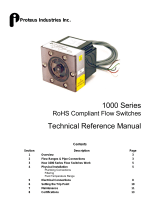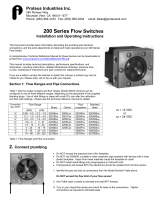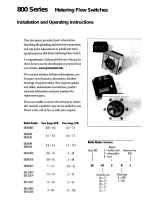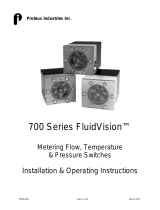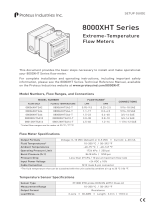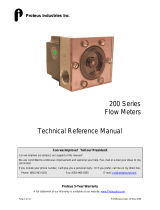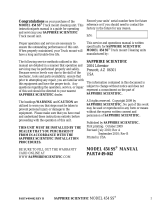Page is loading ...

Proteus Industries Inc.
Proteus Industries Inc.
340 Pioneer Way, Mountain View, CA 94041
Tel: (650) 964-4163 Fax: (650) 965-0304
www.proteusind.com sales@proteusind.com
1000 Series
RoHS Compliant Flow Switches
Installation and Operating Instructions
This document provides basic information describing the plumbing and electrical connections to
install and make operational your 1000 Series Flow Switch.
A comprehensive Technical Reference Manual for these devices can be downloaded
from the Proteus Industries Website at www.proteusind.com/1000/1000TRM.pdf.
This manual includes technical descriptions, performance specifications, dimensions, mounting
instructions, pressure drop curves, maintenance instructions, product warranty information and
part numbers for replacement parts.
If you are unable to access the Internet to obtain this manual, a printed copy can be mailed to
you. Please write, call or fax us with your request.
Flow Ranges
Flow Range Part Number
GPM LPM
Connection
Polypropylene Brass 316 Stainless Steel
0.05 – 0.3 0.2 – 1.5 ¼" FNPT 01004BN03 01004SN03
0.06 – 0.6 0.3 – 2.3 ¼" FNPT 01004PN06
0.1 – 1.0 0.4 – 3.8 ¼" FNPT 01004PN1 01004BN1 01004SN1
0.2 – 2.5 0.75 – 9.5 ¼" FNPT 01004PN2 01004BN2 01004SN2
0.2 – 2.5 0.75 – 9.5
9
⁄
16
-18 SAE 01006SA2
0.3 – 4.5 1.1 – 17 ¼" FNPT 01004PN4 01004BN4 01004SN4
0.3 – 4.5 1.1 – 17
9
⁄
16
-18 SAE 01006SA4
0.6 – 9.0 2.3 – 34 ⅜" FNPT 01006BN9 01006SN9
0.6 – 10.0 2.3 – 38 ⅜" FNPT 01006PN10
0.8 – 10 3 – 38 ¾-16 SAE 01008SA10
1.0 – 14 3.8 – 53 ½" FNPT 01008PN14 01008BN14 01008SN14
1.2 – 16 4.5 – 60 ¾" FNPT 01012BN16 01012SN16
1.2 – 16 4.5 – 60 1
1
⁄
16
-12 SAE 01012SA16
1.5 – 19 6 – 72 ¾" FNPT 01012PN19
3 – 40 11 – 150 ¾" FNPT 01012BN40 01012SN40
4 – 40 15 – 150 1" FNPT 01016BN40 01016SN40
4 – 40 15 – 150 1
5
⁄
16
-12 SAE 01016SA40
4 – 50 15 – 190 1" FNPT 01016PN50
5 – 60 18 – 225 1" FNPT 01016BN60 01016SN60
Temperature & Pressure Operating Limits
Temperature Limit*
Pressure Limit
Flow Sensor Material Faceplate Material
°C °F PSI kPA
Brass Clear polysulfone 90 194 100 690
Polypropylene Clear polysulfone 70 158 75 515
Stainless Steel Clear polysulfone 90 194 100 690
Brass Brass 100 212 250 1720
Stainless Steel Stainless Steel 100 212 250 1720
* This is the fluid temperature that can be sustained with the flow meter cooled by ambient air at 20°C.
Document ID 621000 Rev 002 © Proteus Industries Inc. May 2007

1. Connect Plumbing
01004BN03, 01004SN03, 01004PN06
01004BN1, 01004SN1 and 01004PN1
Liquid flow MUST enter at the
arrowed port D to achieve the
rated flow ranges.
• Do NOT exceed the pressure limit of the faceplate.
• Do NOT use SWAK®, Loctite® or other anaerobic pipe sealants with devices
with a clear plastic faceplate.
Vapor from these materials cause the faceplate to crack!
• Do NOT install metal fittings into polypropylene units. Excessive torque can
cause the sensor to crack.
1. Identify the type and size of connections from the Model Number Table above.
Do NOT exceed the flow limit of your flow sensor!
2. For units 01004BN03, 01004SN03, 01004PN06, 01004BN1, 01004SN1 and
01004PN1, the liquid flow MUST enter the flow sensor at the port with the
SMALLER orifice.
For all other units, orifices are identical at both ports and the liquid flow can
enter at either of the available ports.
3. Use PTFE tape or paste to lubricate and seal NPT threads, or PTFE paste to
lubricate SAE straight threads.
4. Turn on your liquid flow slowly and check for leaks at the connections. Tighten
connections as required to eliminate leaks.
2. Make Electrical Connections
Color
Function
Brown
Supply Voltage 24 VDC
White
24 V Return 0 VDC
Black
Relay Common
Red
Relay NO Contact
Green
Relay NC Contact
1. Locate the 24VDC power source and turn it OFF.
2. Connect the WHITE wire to the Return or -VDC power connection.
3. The relay is energized with the relay common contact connecting to the
relay NO contact when the flow rate is above the trip point setting.
The relay is not energized with the relay common contact connecting to the
relay NC contact when the flow rate is below the trip point setting.
z To monitor the NC relay state, connect your external device to the
BLACK and GREEN wires.
z To monitor the NO relay state, connect your external device to the
BLACK and RED wires.
4. Connect the BROWN wire to the +24VDC source connection.
5. Turn the 24VDC power source ON.
3. Adjust Trip Point If a label on the back cover shows a factory-set trip point, no adjustment is needed.
1. Remove the green label on the back of the unit to access the trip point adjustment screw.
2. Install the flow switch in your actual circuit or calibration bench.
If a calibration bench is used, ensure that the inlet fitting is of the same form as that
used in your actual circuit.
3. Adjust the actual flow rate to the minimum flow rate at which the trip point is to be set.
Ensure that all air is removed from the flow switch BEFORE adjusting the trip point.
4. Connect an ohmmeter between the black and green or black and red wires.
5. With a small insulated screwdriver, adjust the potentiometer until the ohmmeter shows that
the relay has changed state.
Turn the potentiometer clockwise to INCREASE the trip point flow rate.
Turn the potentiometer counter-clockwise to DECREASE the trip point flow rate.
6. The trip point is slightly different for rising and falling flow rates.
It is recommended that the trip point be set on a falling flow rate.
Document ID 621000 Rev 002 © Proteus Industries Inc. May 2007
/
